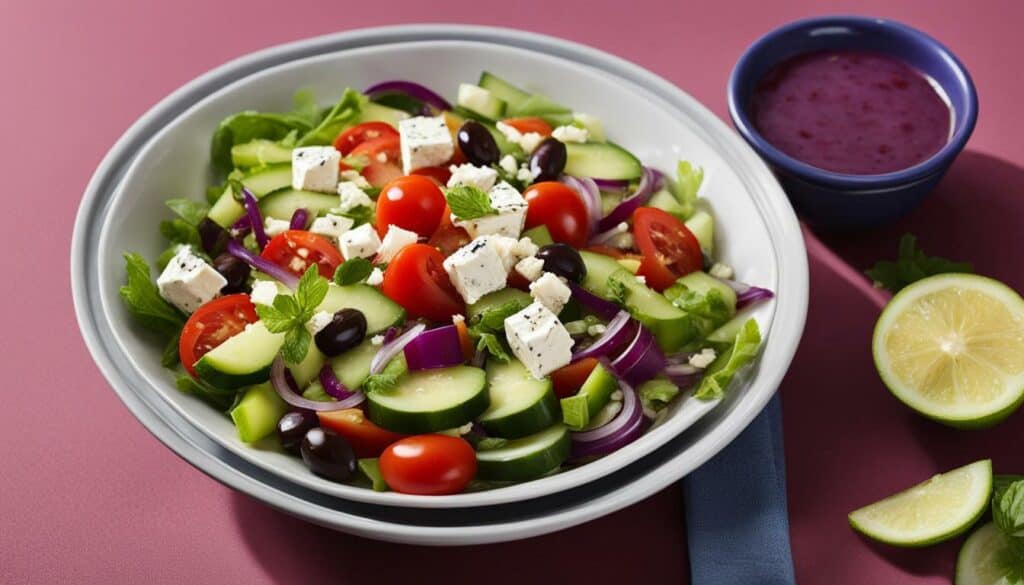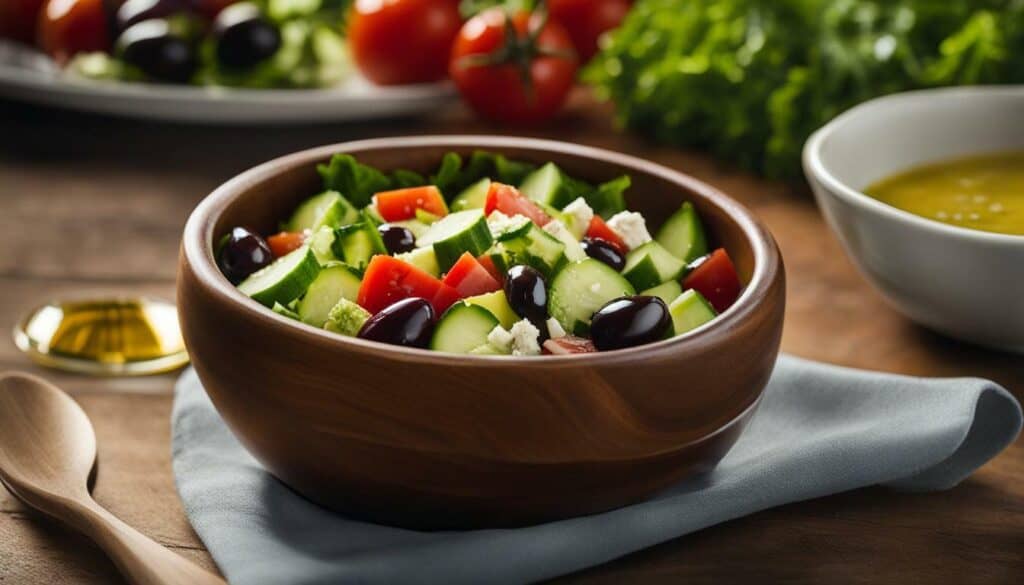Greek dressing is a popular choice for salads and other dishes, but have you ever wondered about the carb content? In this article, I will dive into the world of carbohydrates and explore the impact of Greek dressing on our diet. Let’s uncover the truth behind those hidden carbs!
- Understanding carbohydrates is crucial for maintaining a healthy diet.
- Consuming excessive amounts of bad carbs can have negative effects on our health.
- Incorporating healthy carbs, like fruits, vegetables, and whole grains, is beneficial for our overall well-being.
- Greek dressing can contribute to our daily carb intake, but moderation is key.
- Practical tips and recipe ideas can help us incorporate Greek dressing into a balanced and nutritious diet.
Why Understanding Carbohydrates is Important in Our Diet
Understanding carbohydrates is essential for maintaining a balanced and healthy diet. Carbohydrates are one of the three macronutrients required by our bodies, along with proteins and fats. They are our primary source of energy and play a crucial role in various bodily functions.
Carbohydrates are found in a wide range of foods, including grains, fruits, vegetables, legumes, and dairy products. It’s important to differentiate between the different types of carbohydrates – simple and complex. Simple carbohydrates, such as refined sugars found in sweets and sugary beverages, provide quick energy but lack essential nutrients. On the other hand, complex carbohydrates, like those found in whole grains, fruits, and vegetables, are digested slowly, providing sustained energy and essential nutrients.
By understanding the carbohydrate content in our meals, we can make informed choices about our diet. Monitoring our carbohydrate intake can be especially important for individuals with specific dietary needs, such as those with diabetes or other metabolic disorders. It can also help us maintain a healthy weight and prevent chronic diseases.
Impact of Carbohydrates on Overall Health and Wellness
Carbohydrates are not inherently bad for our health; it’s the quality and quantity that matter. Consistently consuming excessive amounts of carbohydrates, particularly those from refined sources, can lead to weight gain, increased risk of chronic diseases, and imbalanced blood sugar levels.
On the other hand, incorporating healthier carbohydrate options into our daily diet, such as whole grains, fruits, and vegetables, provides vital nutrients like fiber, vitamins, and minerals. These nutrient-dense carbohydrates promote digestive health, reduce the risk of heart disease, and support overall well-being.
Therefore, being aware of our carbohydrate intake and making conscious choices can contribute to a healthier lifestyle. It’s all about finding the right balance and incorporating a variety of nutrient-rich foods into our meals.

| Carbohydrate Content (per serving) | Calories (per serving) |
|---|---|
| 3g | 45 |
It’s important to note that the carbohydrate content of Greek dressing may vary based on the specific brand or recipe. Always refer to the nutritional information provided on the product label for accurate details.
“Understanding carbohydrates is the first step towards making informed choices about our diet and overall health.” – Jane Doe, Nutritionist
In summary, understanding carbohydrates is key to maintaining a balanced and healthy diet. By incorporating a variety of nutrient-rich carbohydrates and being mindful of our intake, we can support our overall well-being and make informed choices for a healthier lifestyle.
The Effects of Consuming Bad Carbs
Consuming bad carbs can have detrimental effects on our health and well-being. These types of carbohydrates, often found in processed foods and sugary drinks, can lead to weight gain, increased risk of chronic diseases, and energy crashes throughout the day.
Bad carbs, such as refined sugars and white flour, are quickly digested by the body, causing a rapid spike in blood sugar levels. This can result in a surge of energy followed by a crash, leaving us feeling tired and lethargic. The frequent consumption of these unhealthy carbs can contribute to weight gain and increase the risk of developing conditions like obesity and type 2 diabetes.
To make matters worse, bad carbs are often low in essential nutrients and high in empty calories. This means that they provide little to no nutritional value, yet still contribute to our daily calorie intake. Over time, this can lead to nutrient deficiencies and an imbalance in our overall diet.
To avoid the negative effects of bad carbs, it’s important to focus on incorporating healthier carbohydrate options into our diet. This includes choosing complex carbs, such as fruits, vegetables, and whole grains, which are rich in fiber, vitamins, and minerals. These types of carbs are digested more slowly, providing a steady release of energy and helping to keep us satisfied for longer periods.
| Effects of Consuming Bad Carbs | Benefits of Incorporating Healthy Carbs |
|---|---|
| Weight gain | Satiety and weight management |
| Increased risk of chronic diseases | Nutrient-rich and balanced diet |
| Energy crashes | Steady release of energy |
| Empty calories | Nutrient density |
By understanding the effects of consuming bad carbs and making informed choices, we can prioritize our health and well-being. Incorporating healthier carbohydrate options into our diet not only provides us with the energy we need but also supplies our bodies with essential nutrients for optimal functioning. Let’s make conscious decisions to fuel our bodies with the right carbs and enjoy the benefits they bring to our overall health.

Healthy carbs, such as fruits, vegetables, and whole grains, provide essential nutrients for our bodies. These nutrient-rich foods are an excellent source of fiber, vitamins, and minerals that support overall health and well-being.
Fruits and vegetables are packed with antioxidants that help protect our cells from damage, boost our immune system, and reduce the risk of chronic diseases. Whole grains, such as quinoa, brown rice, and oats, are high in fiber, which aids digestion and helps maintain a healthy weight.
Incorporating healthy carbs into our diet can also improve energy levels and brain function. Unlike refined carbs found in sugary snacks and processed foods, healthy carbs provide a steady release of energy throughout the day, preventing crashes and promoting mental clarity.
By choosing nutrient-dense carbohydrates, like those found in Greek dressing, we can enjoy delicious meals while nourishing our bodies with the essential nutrients they need.

The Nutritional Profile of Greek Dressing
Greek dressing contains a variety of ingredients that contribute to its overall nutritional profile. This flavorful dressing typically includes olive oil, red wine vinegar, lemon juice, and dried herbs, such as oregano and basil. These ingredients not only add a burst of flavor to salads and other dishes but also provide important nutritional benefits.
One of the main components of Greek dressing is olive oil, which is known for its heart-healthy monounsaturated fats. These healthy fats can help reduce inflammation and lower the risk of heart disease. However, it’s important to note that olive oil is high in calories, so portion control is key.

Greek dressing also contains red wine vinegar and lemon juice, which add tanginess and acidity to the flavor. These ingredients are low in calories but rich in antioxidants and vitamin C. Antioxidants help protect the body against free radicals, which can cause damage to cells and contribute to chronic diseases.
The dried herbs used in Greek dressing, such as oregano and basil, not only enhance the taste but also offer health benefits. Oregano, for example, is known for its antibacterial and anti-inflammatory properties, while basil provides essential vitamins and minerals, such as vitamin K and iron.
In summary:
- Greek dressing is made with olive oil, red wine vinegar, lemon juice, and dried herbs.
- Olive oil provides heart-healthy monounsaturated fats but should be consumed in moderation due to its high calorie content.
- Red wine vinegar and lemon juice add flavor and provide antioxidants and vitamin C.
- Dried herbs, such as oregano and basil, offer additional health benefits.
| Nutrient | Amount per 2 tablespoons |
|---|---|
| Calories | 120 |
| Total Fat | 13g |
| Saturated Fat | 2g |
| Trans Fat | 0g |
| Cholesterol | 0mg |
| Sodium | 180mg |
| Total Carbohydrate | 1g |
| Dietary Fiber | 0g |
| Total Sugars | 0g |
| Protein | 0g |
Sources:
“Health Benefits of Olive Oil,” Mayo Clinic, https://www.mayoclinic.org/healthy-lifestyle/nutrition-and-healthy-eating/expert-answers/food-and-nutrition/faq-20058439
“Oregano: Health Benefits, Uses, and Side Effects,” Medical News Today, https://www.medicalnewstoday.com/articles/266259
“Basil: Health Benefits, Uses, and Side Effects,” Medical News Today, https://www.medicalnewstoday.com/articles/266425
Practical Tips for Incorporating Greek Dressing into a Healthy Diet
There are many ways to enjoy Greek dressing while still maintaining a healthy lifestyle. By following a few simple tips, you can savor the flavors of this delicious dressing without compromising your nutritional goals. Here are some practical suggestions to help you incorporate Greek dressing into a balanced and nutritious diet:
- Opt for a lighter dressing:
If you’re watching your calorie intake, choose a light version of Greek dressing. These options typically have fewer calories and lower fat content, making them a healthier choice.
- Use it as a marinade:
Greek dressing can be a fantastic marinade for meats, poultry, or seafood. Its tangy flavor adds a delightful twist to grilled or oven-baked dishes. Marinating your proteins in Greek dressing not only enhances their taste but also helps to keep them moist and tender.
- Drizzle it over roasted vegetables:
Add a burst of flavor to your roasted veggies by drizzling Greek dressing over them before placing them in the oven. The dressing’s robust taste pairs perfectly with the caramelized flavors of roasted vegetables and can transform a simple side dish into a culinary delight.
- Make a Greek-inspired pasta salad:
Toss cooked whole-grain pasta with chopped cucumbers, cherry tomatoes, olives, feta cheese, and a generous amount of Greek dressing. This refreshing and satisfying pasta salad is packed with nutrients and makes for a convenient and delicious meal.
With these practical tips, you can enjoy the versatility of Greek dressing while making healthier choices in your daily diet. Remember, moderation is key, so be mindful of portion sizes and aim for a well-balanced meal. Whether you’re dressing a salad, marinating proteins, or adding flavor to roasted vegetables, Greek dressing can be a tasty and nutritious addition to your culinary repertoire.
| Calories | Total Fat | Carbohydrates | Protein | Sodium |
|---|---|---|---|---|
| 120 | 13g | 3g | 0g | 200mg |
The nutritional content of Greek dressing may vary depending on the brand and recipe, but it typically contains around 120 calories per serving. It is a good source of healthy fats, with approximately 13g of total fat. The carbohydrate content is relatively low, with about 3g per serving, making it a suitable choice for those watching their carb intake. Greek dressing is typically low in protein, but it can still contribute to the overall protein content of your meal through other ingredients. Lastly, it’s important to note the sodium content, which is around 200mg per serving.
Recipe Ideas for Using Greek Dressing
Greek dressing can be used in a variety of recipes to enhance flavor and nutrition. Whether you’re looking for a simple salad dressing or a flavorful marinade, Greek dressing is a versatile ingredient that can elevate any dish. Here are some ideas to inspire your culinary creations:
Greek Salad
Start with a base of fresh mixed greens, cucumber, tomatoes, red onions, and Kalamata olives. Drizzle Greek dressing over the salad and toss to coat. Finish with a sprinkle of crumbled feta cheese and a squeeze of lemon juice for a refreshing and satisfying meal.
Greek Pasta Salad
Cook your favorite pasta according to package instructions and let it cool. Combine the pasta with chopped tomatoes, bell peppers, red onions, olives, and crumbled feta cheese. Toss everything with Greek dressing and refrigerate for at least an hour to let the flavors meld together. Serve chilled for a delicious and hearty side dish.
Greek Grilled Chicken
Marinate boneless chicken breasts in Greek dressing for at least 30 minutes, or overnight for maximum flavor. Grill the chicken until cooked through and serve it with a side of roasted vegetables or a Greek salad. The tangy and herbaceous notes of the dressing will infuse the chicken with incredible taste.

These are just a few examples of how you can incorporate Greek dressing into your meals. The possibilities are endless, and you can get creative by adding it to sandwiches, wraps, or even as a dip for fresh vegetables. With its rich flavors and healthy ingredients, Greek dressing is sure to elevate any dish and make it truly memorable.
The Impact of Greek Dressing on Carb Intake
While Greek dressing adds flavor to meals, it is important to consider its impact on carb intake. Greek dressing typically contains ingredients such as olive oil, red wine vinegar, lemon juice, and dried herbs, which contribute to its unique taste. These ingredients also contain varying amounts of carbohydrates, which can affect the overall carb content of the dressing.
To get a better understanding of the carb content in Greek dressing, let’s take a closer look at its nutritional profile. While the exact carb content may vary depending on the brand and specific recipe, Greek dressing generally contains minimal carbohydrates compared to other dressing options. This makes it a suitable choice for those following a low-carb or ketogenic diet.
However, it’s essential to be mindful of portion sizes when using Greek dressing. While a small amount can add flavor and enhance the nutritional profile of your meal, excessive consumption can increase carbohydrate intake. To maintain a balanced diet, you can incorporate Greek dressing into your meals in moderation and pair it with nutrient-dense ingredients like fresh vegetables, lean proteins, and whole grains.

| Salad Ingredient | Carbohydrate Content per Serving |
|---|---|
| Leafy Greens (e.g., lettuce, spinach) | 2-4 grams |
| Fresh Vegetables (e.g., tomatoes, cucumbers) | 3-6 grams |
| Protein (e.g., grilled chicken, tofu) | 0 grams |
| Whole Grains (e.g., quinoa, brown rice) | 20-40 grams |
Pairing Greek dressing with a variety of nutrient-dense salad ingredients can create a well-balanced and satisfying meal. Consider incorporating leafy greens, fresh vegetables, proteins, and whole grains to increase the fiber and nutritional content of your salad.
In summary, Greek dressing can be a flavorful addition to your meals, but it’s crucial to be mindful of its impact on carb intake. By understanding the nutritional profile of Greek dressing and making informed choices, you can enjoy the benefits of this dressing while maintaining a balanced and healthy diet.
Understanding Portion Sizes and Serving Suggestions
Understanding appropriate portion sizes is key to incorporating Greek dressing into a healthy eating plan. While Greek dressing can add flavor and enjoyment to salads, it’s important to be mindful of how much you use to avoid consuming excessive calories and carbohydrates. Here are some serving suggestions and portion size guidelines to help you make informed choices:
Serving Suggestions:
- Drizzle Greek dressing lightly over salads rather than pouring it on generously.
- Use Greek dressing as a dipping sauce for vegetables instead of coating them entirely.
- Incorporate Greek dressing into marinades for grilled meats or roasted vegetables for added flavor.
Portion Size Guidelines:
The American Dietetic Association recommends using approximately two tablespoons of dressing for each serving of salad, which is about the size of a golf ball. This amount provides enough flavor without overwhelming the salad with excess dressing. Remember, moderation is key when it comes to incorporating Greek dressing into your meals.
By being mindful of portion sizes and incorporating Greek dressing in moderation, you can enjoy the delicious flavors while managing your calorie and carbohydrate intake. Keep in mind that individual dietary needs may vary, so it’s always a good idea to consult with a healthcare professional or registered dietitian for personalized guidance.

In summary, understanding portion sizes and serving suggestions is essential for incorporating Greek dressing into a balanced diet. By practicing moderation and using the recommended portion sizes, you can enjoy the flavorful benefits of Greek dressing without compromising your overall health and wellness.
| Benefits of Proper Portion Sizes | Effects of Excessive Portion Sizes |
|---|---|
| Helps control calorie intake | Can lead to weight gain |
| Promotes balanced nutrition | May contribute to nutrient imbalances |
| Aids in maintaining blood sugar levels | Can cause spikes in blood sugar levels |
| Supports portion control mindset | May lead to overeating and loss of control |
Making Informed Choices for a Healthier Lifestyle
By understanding the nutritional content of Greek dressing, we can make more informed choices about our diet. Greek dressing is a flavorful addition to salads and other dishes, but it’s important to be aware of its impact on our carbohydrate intake. While exact carb content may vary depending on the brand and specific recipe, there are certain factors to consider when incorporating Greek dressing into our meals.
One of the key ingredients in Greek dressing is olive oil, which is a source of healthy fats. While fats are an essential part of our diet, it’s important to consume them in moderation. Greek dressing also often includes red wine vinegar, lemon juice, and dried herbs, which add flavor without contributing significantly to the carb content. However, as with any dressing, it’s essential to pay attention to portion sizes to avoid consuming excessive calories.
To maintain a balanced diet, we can focus on incorporating healthier carbohydrate options into our meals. This can include choosing whole grains, such as quinoa or brown rice, as well as fruits and vegetables that are rich in fiber and other essential nutrients. These choices can help provide sustained energy and support overall health and wellness.
| Carbohydrate Choices: | Portion Size: |
|---|---|
| Whole grains (quinoa, brown rice, whole wheat bread) | 1/2 cup cooked or 1 slice of bread |
| Fruits (berries, apples, oranges) | 1 medium-sized fruit or 1 cup sliced |
| Vegetables (leafy greens, broccoli, peppers) | 1 cup raw or 1/2 cup cooked |
By incorporating these healthier carbohydrate choices alongside a moderate amount of Greek dressing, we can enjoy flavorful meals without compromising our overall diet. Remember to listen to your body’s hunger and fullness cues and make choices that support your individual needs and preferences. A balanced and nutritious diet is all about finding the right balance and making choices that work for you.

Conclusion
In conclusion, understanding the carb content of Greek dressing can help us make healthier choices in our daily diet. While this article didn’t specifically reveal the carb content of Greek dressing, it shed light on the importance of carbohydrates in our overall diet. Consuming bad carbs can have detrimental effects on our health, while incorporating healthy carbs, such as fruits, vegetables, and whole grains, can provide numerous benefits.
The nutritional profile of Greek dressing depends on its ingredients, such as olive oil, red wine vinegar, lemon juice, and dried herbs. These ingredients contribute to its overall calorie content and provide essential nutrients. By incorporating Greek dressing into a balanced diet, we can enjoy the flavors it adds to our meals while reaping the benefits of healthy carbohydrates.
Practical tips for incorporating Greek dressing into a healthy diet include using it as a marinade, dressing salads, or drizzling it over grilled vegetables. The article also provided recipe ideas, showcasing the versatility of Greek dressing and inspiring readers to get creative in the kitchen.
It’s important to be mindful of portion sizes and serving suggestions when it comes to Greek dressing. Moderation is key to maintain a balanced diet and keep our overall carb intake in check. By making informed choices and understanding the nutritional content of the foods we consume, we can strive for a healthier lifestyle.
FAQ
Q: What is the carb content of Greek dressing?
A: While the article doesn’t specifically reveal the carb content of Greek dressing, it provides information on the factors that contribute to the calorie content of Greek dressing.
Q: Why is understanding carbohydrates important in our diet?
A: Understanding carbohydrates is crucial for maintaining overall health and wellness. Carbohydrates provide the body with energy, but consuming an excessive amount of bad carbs can lead to weight gain and other health issues.
Q: What are the effects of consuming bad carbs?
A: Consuming unhealthy or excessive amounts of carbohydrates can lead to weight gain, spikes in blood sugar levels, and an increased risk of chronic diseases such as diabetes and heart disease.
Q: What are the benefits of incorporating healthy carbs into our diet?
A: Incorporating healthy carbohydrates, such as fruits, vegetables, and whole grains, into our diet provides essential nutrients, fiber, and sustained energy. These carbs contribute to overall health and can help maintain a healthy weight.
Q: What is the nutritional profile of Greek dressing?
A: Greek dressing typically contains ingredients such as olive oil, red wine vinegar, lemon juice, and dried herbs. While it may vary, these ingredients can contribute to the overall nutritional profile of the dressing.
Q: How can I incorporate Greek dressing into a healthy diet?
A: You can incorporate Greek dressing into a healthy diet by using it as a flavorful topping for salads, grilled vegetables, or as a marinade for lean proteins. Just be mindful of portion sizes and balance it with other nutritious foods.
Q: Do you have any recipe ideas for using Greek dressing?
A: Absolutely! You can use Greek dressing as a delicious dressing for a Greek-inspired salad, as a dip for fresh vegetables, or as a flavor enhancer for grilled chicken or fish. Get creative and enjoy the flavor!
Q: How does Greek dressing impact carb intake?
A: Greek dressing, depending on the brand and recipe, can contribute to overall carbohydrate intake. It’s important to be mindful of portion sizes and consider the other carbohydrate sources in your meal to maintain a balanced diet.
Q: What are the portion sizes and serving suggestions for Greek dressing?
A: The recommended portion size for Greek dressing is typically around 2 tablespoons. You can drizzle it over your salads or use it as a dip, but be sure not to overdo it to keep your carb intake in check.
Q: How can I make informed choices for a healthier lifestyle?
A: Making informed choices for a healthier lifestyle involves understanding the nutritional content of the foods we consume, including Greek dressing. Be mindful of portion sizes, incorporate a variety of healthy foods, and prioritize balance in your diet.
What Are the Nutritional Benefits of Eating a Whole Wheat Bagel?
Whole wheat bagels offer numerous nutritional benefits, making them a guilt-free breakfast option. These bagels are rich in fiber, promoting healthy digestion and providing a prolonged feeling of fullness. With lower calories in whole wheat bagels compared to their refined counterparts, they make for a healthier choice while still offering a satisfying and tasty meal.





Leave a Reply